
A Mallet locomotive is a type of compound articulated steam locomotive, invented by the Swiss engineer Anatole Mallet (1837–1919).

The Union Pacific Big Boy is a type of simple articulated 4-8-8-4 steam locomotive manufactured by the American Locomotive Company (ALCO) between 1941 and 1944 and operated by the Union Pacific Railroad in revenue service until 1962.
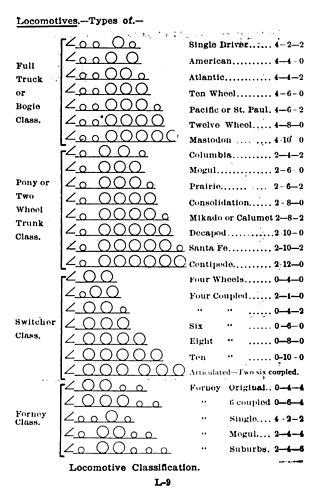
The Whyte notation is a classification method for steam locomotives, and some internal combustion locomotives and electric locomotives, by wheel arrangement. It was devised by Frederick Methvan Whyte, and came into use in the early twentieth century following a December 1900 editorial in American Engineer and Railroad Journal.

A 2-8-8-4 steam locomotive, under the Whyte notation, has two leading wheels, two sets of eight driving wheels, and a four-wheel trailing truck. The type was generally named the Yellowstone, a name given it by the first owner, the Northern Pacific Railway, whose lines ran near Yellowstone National Park. Seventy-two Yellowstone-type locomotives were built for four U.S. railroads.
The UIC classification of locomotive axle arrangements, sometimes known as the German classification or German system, describes the wheel arrangement of locomotives, multiple units and trams. It is used in much of the world, notable exceptions being the United Kingdom and North America.
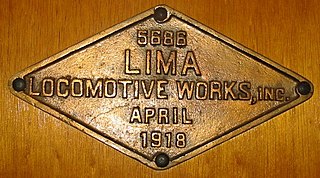
Lima Locomotive Works (LLW) was an American firm that manufactured railroad locomotives from the 1870s through the 1950s. The company's name is derived from the location of its main manufacturing plant in Lima, Ohio. The shops were located between the Erie Railroad main line, the Baltimore & Ohio's Cincinnati-Toledo main line and the Nickel Plate Road main line and shops.

In the Whyte notation for classifying the wheel arrangement of steam locomotives, an 0-8-8-0 is a locomotive with two sets of eight driving wheels and neither leading wheels nor trailing wheels. Two sets of driving wheels would give far too long a wheelbase to be mounted in a fixed locomotive frame, so all 0-8-8-0s have been articulated locomotives of the Mallet type, whether simple or compound. In the UIC classification, this arrangement would be, refined to Mallet locomotives, (D)D. The type was sometimes called Angus in North America.
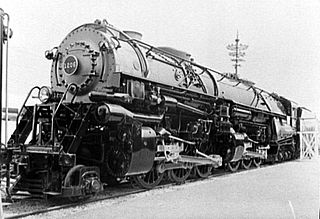
In the Whyte notation for the classification of steam locomotive wheel arrangement, a 2-6-6-4 is a locomotive with a two-wheel leading truck, two sets of six driving wheels, and a four-wheel trailing truck. All 2-6-6-4s are simple articulated locomotives.
Under the Whyte notation for the classification of steam locomotives, 0-10-2 represents the wheel arrangement of no leading wheels, ten powered and coupled driving wheels on five axles, and two trailing wheels on one axle.

A 2-8-8-2, in the Whyte notation for describing steam locomotive wheel arrangements, is an articulated locomotive with a two-wheel leading truck, two sets of eight driving wheels, and a two-wheel trailing truck. The equivalent UIC classification is, refined to Mallet locomotives, (1′D)D1′ 4v. These locomotives usually employ the Mallet principles of articulation—with the rear engine rigidly attached to the boiler and the front engine free to rotate—and compounding. The 2-8-8-2 was a design largely limited to American locomotive builders. The last 2-8-8-2 was retired in 1962 from the N&W's roster, two years past the ending of steam though steam was still used on steel mill lines and other railroads until 1983.
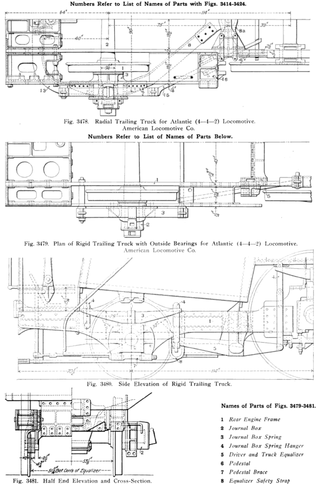
On a steam locomotive, a trailing wheel or trailing axle is generally an unpowered wheel or axle (wheelset) located behind the driving wheels. The axle of the trailing wheels is usually located in a trailing truck. On some large locomotives, a booster engine was mounted on the trailing truck to provide extra tractive effort when starting a heavy train and at low speeds on gradients.

Under the Whyte notation for the classification of steam locomotives, a 4-8-8-2 is a locomotive with four leading wheels, two sets of eight driving wheels, and a two-wheel trailing truck.

In the Whyte notation for classifying steam locomotives by wheel arrangement, a 4-6-6-4 is a railroad steam locomotive that has four leading wheels followed by two sets of six coupled driving wheels and four trailing wheels. 4-6-6-4's are commonly known as Challengers.
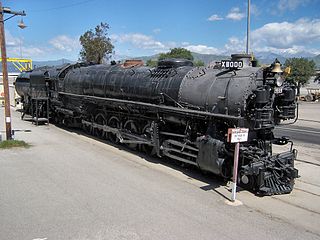
The Union Pacific Railroad 9000 Class was a class of 88 steam locomotives, built by ALCO for the Union Pacific between 1926 and 1930.
Under the Whyte notation for the classification of steam locomotives, a 2-8-8-8-4 has two leading wheels, three sets of eight driving wheels, and four trailing wheels.

A 2-6-8-0 steam locomotive, in the Whyte notation for describing locomotive wheel arrangements, has two leading wheels, a set of six driving wheels, a set of eight driving wheels, and no trailing wheels. These locomotives usually employ the Mallet principle of articulation, with a swinging front engine and a rigidly attached rear engine.

The Union Pacific Challengers are a type of simple articulated 4-6-6-4 steam locomotive built by American Locomotive Company (ALCO) from 1936 to 1944 and operated by the Union Pacific Railroad until the late 1950s.
In Whyte notation, a 4-6-6-2 is a steam locomotive with four leading wheels in an unpowered bogie at the front of the locomotive followed by two sets of driving wheels with six wheels each, followed by two unpowered trailing wheels at the rear of the locomotive.

A triplex locomotive was a steam locomotive that divided the driving force on its wheels by using three pairs of cylinders to drive three sets of driving wheels. Any such locomotive will inevitably be articulated. All triplex locomotives built were of the Mallet type, but with an extra set of driving wheels under the tender. The concept was extended to locomotives with four, five or six sets of drive wheels. However, these locomotives were never built, except for one quadruplex locomotive in Belgium.
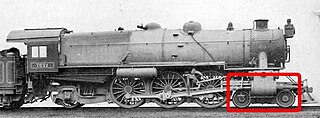
The leading wheel or leading axle or pilot wheel of a steam locomotive is an unpowered wheel or axle located in front of the driving wheels. The axle or axles of the leading wheels are normally located on a leading truck. Leading wheels are used to help the locomotive negotiate curves and to support the front portion of the boiler.
















